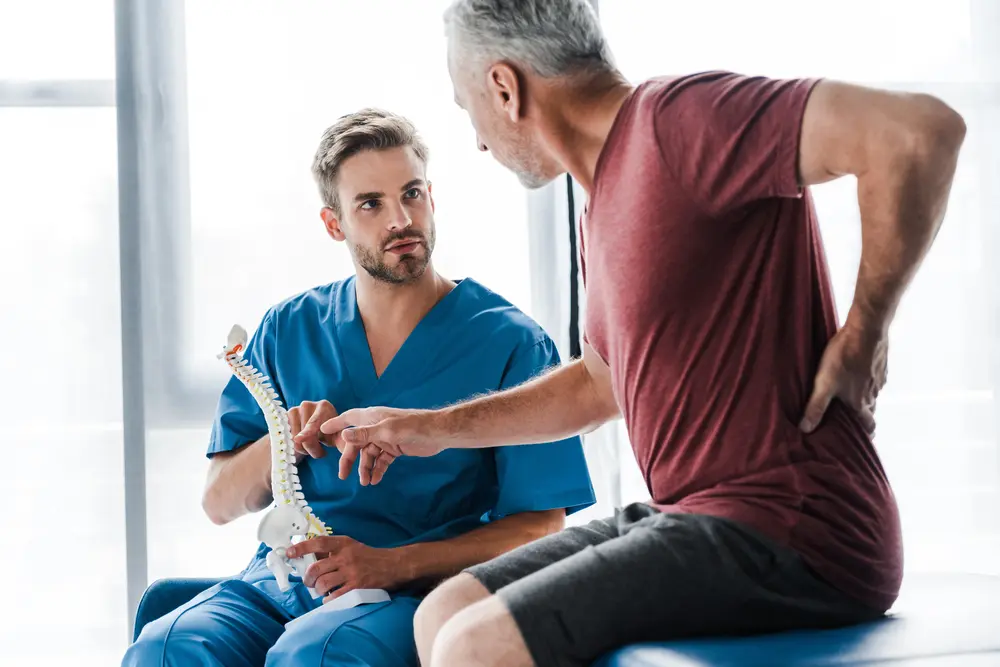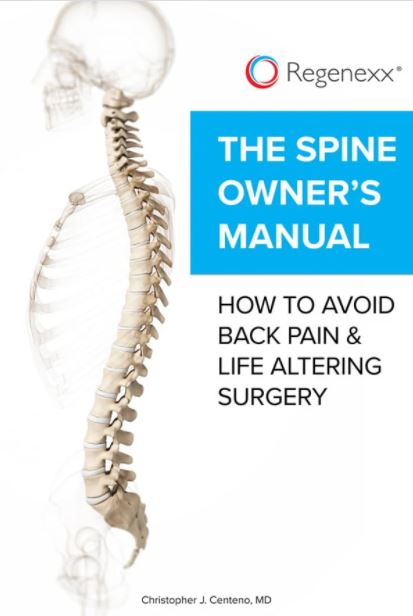Back pain is a common complaint among golfers, impacting both amateur enthusiasts and professional athletes. Golf, while seemingly low-impact, involves repetitive, high-intensity movements that can stress the spine and surrounding structures.
Understanding the causes, symptoms, and preventative measures for golf-related back pain can help maintain performance and long-term health.
Golf And Back Pain
The golf swing requires a complex interplay of biomechanical forces that places pressure on the spine. The rotational and torsional stresses involved, combined with poor posture or improper technique, contribute significantly to back pain.
The Mechanics of Golf Swing
The golf swing involves rotational movement of the trunk while stabilizing the lower body. Studies show that these motions can increase the risk of spinal injury due to compressive and shear forces on intervertebral discs and facet joints (Gluck et al., 2008).
The follow-through phase creates significant lumbar extension and contralateral rotation, which can be key contributors to pain depending on the person (Lindsay & Horton, 2002). Pain may occur in these areas of the back:
- Low Back Pain: Often due to lumbar muscle strain, flared up arthritic facet joints, disc protrusions which can irritate nerves, etc.
- Middle and Upper Back Pain: Usually resulting from overcompensation during a swing or poor posture. Pain from the cervical spine can radiate into the upper back and around the shoulder blades as well.
What Golfer’s Back Pain Feels Like
Back pain from golf can manifest immediately after a round or several days later, depending on the severity and nature of the injury. Symptoms include:
- Dull Ache on One Side of the Lower Back: Commonly associated with muscle strain.
- Pain Extending to the Hip or Thigh: Indicative of nerve root irritation “sciatica” or potential facet joint pain.
- Nerve Pain in the Leg: Suggesting possible disc herniation or nerve root compression (McHardy et al., 2006).
- Lower Back Stiffness: A result of repetitive stress on spinal joints.
- Lordosis (Change in Curvature of the Lower Spine): Exacerbated by poor posture and swing mechanics during play. The lumbar spine is supposed to have a lordotic curve. Issues acute and chronic can create changes in the degree of that curve.
Common Golf-Related Back Injuries
Golfers are susceptible to various back injuries due to the sport’s repetitive movements and physical demands. These injuries can range in severity and recovery time.
Muscle Strains
Muscle strains are among the most common injuries in golfers. They often occur due to overuse, poor swing mechanics, or inadequate warm-up routines. When the muscles surrounding the spine are overstressed, they can become strained, leading to discomfort and reduced mobility.
Fortunately, most muscle strains resolve with conservative treatments such as heat therapy, mobility exercises, gentle strengthening routines, physical therapy, and analgesics like acetaminophen.
Disc Herniations
Repetitive loading of the spine, particularly during powerful golf swings, can contribute to disc herniations. This condition occurs when the soft inner portion of a spinal disc pushes through its outer layer, potentially compressing nearby nerves.
Symptoms often include radiating pain, numbness, or tingling that may extend from the lower back into the glutes, thigh, calf, or foot (Van Mechelen et al., 1992)
Exacerbated Facet Arthritis
Golf’s repetitive twisting and bending motions can aggravate pre-existing arthritis in the spine. Facet joints help stabilize the spine, and when arthritis is present, these movements may increase pain and stiffness. If left untreated, chronic discomfort can develop, impacting a golfer’s ability to rotate effectively and maintain a consistent swing.
Golf-Related Accidents
Beyond repetitive stress injuries, falls, slips, and golf cart accidents can lead to acute back injuries, fractures, or damage to the spine and surrounding tissues. Sudden impacts can strain muscles, misalign joints, or even cause structural damage to the spine.
Treatments
The treatment for golf-related back pain depends on the severity of the condition and the individual’s overall health. While mild cases may resolve with home care, more persistent or severe pain may require non-invasive procedures to support recovery and improve function.
Home Remedies
For mild muscle strains and discomfort, rest and activity modification are essential to allow the body time to recover. Avoiding movements that aggravate the pain, such as excessive twisting or bending, can prevent further strain. Over-the-counter analgesics like acetaminophen (Tylenol) may help manage temporary pain flares, making it easier to stay active while the back heals.
Additionally, gentle stretching and heat therapy can improve flexibility and promote blood flow to the affected area, supporting muscle relaxation and recovery.
Non-Invasive Procedures
When home remedies are not enough to relieve symptoms, non-invasive treatments can help manage pain and restore mobility.
- Pain management therapies, such as physical therapy and chiropractic care, focus on strengthening the muscles that support the spine, improving alignment, and reducing tension in overworked areas.
- Shockwave Therapy, a non-invasive technique that delivers sound waves to the affected tissue, has been shown to promote tissue repair and reduce pain (Gerdesmeyer et al., 2008). This therapy may benefit golfers experiencing chronic back pain due to soft tissue injuries or degenerative changes.
- Orthobiologic Treatments such as PRP and bone marrow concentrate (containing mesenchymal stem cells) can help provide medium to longer-term symptomatic improvement when the above treatments are not getting you where you want to be. The Centeno-Schultz Clinic physicians are experts in utilizing orthobiologics to help you heal and reduce the need for invasive surgical procedures when appropriate.
- Surgery should be a last resort if all other treatment options fail.
How To Prevent Back Pain When Golfing
Taking proactive measures can mitigate the risk of back pain and improve your golfing experience.
Perform Warm-Up Activities Before Golfing
Engaging in stretching exercises before a round of golf can improve muscle flexibility and enhance joint range of motion. A dynamic warm-up routine helps prepare the muscles for movement, reducing the risk of strain during the game. Additionally, staying hydrated before, during, and after play supports muscle function and prevents fatigue-related injuries.
Improve Your Swing Techniques
Proper swing mechanics can prevent unnecessary stress on the lower back. Working with a Titleist Performance Institute (TPI) certified golf coach can help golfers refine their swing to avoid movements that may exacerbate pain or contribute to injury. Golfers interested in expert guidance can find a TPI-certified professional at www.mytpi.com.
Incorporate Golf Stance
A well-balanced stance helps distribute weight evenly and minimizes stress on the spine. Golfers should:
- Keep the spine upright.
- Bend forward at the hips, not the waist.
- Slightly bend the knees and maintain a shoulder-width stance.
Focus on the Core
A strong core provides support to the spine and enhances overall stability during the golf swing. However, core strengthening goes beyond simple sit-ups—it involves training deep stabilizing muscles to protect the lower back. Maintaining joint stability while swinging is essential for managing discomfort and preventing flare-ups during play.
Perform Stretches Before and After Golf
A comprehensive stretching routine—which takes as little as 10 minutes—can warm up muscles before play and aid in cooling down afterward. Stretching post-game helps reduce muscle tension and enhances recovery, making it an essential part of injury prevention.
Lessen the Force on the Low Back
A controlled, smooth golf swing helps limit excess strain on the lumbar spine. Developing a consistent, low-impact swing technique reduces compensatory movements that may lead to discomfort. Optimizing swing mechanics through professional instruction and proper body awareness can significantly minimize stress on the lower back, helping golfers maintain their performance without aggravating existing pain.
By incorporating these preventative strategies, golfers can protect their backs, reduce discomfort, and improve overall mobility on the course.
Ace The Game Without The Throbbing Back Pain
By understanding the biomechanics of golf and adopting preventative measures, golfers can reduce the likelihood of back pain. Whether you’re a beginner or a seasoned golfer, maintaining proper technique, strengthening the core, and seeking timely treatment are essential for enjoying the sport pain-free.
References
- Gluck, G. S., Bendo, J. A., & Spivak, J. M. (2008). The lumbar spine and low back pain in golf: a literature review of swing biomechanics and injury prevention. Spine Journal, 8(5), 778–788.
- Lindsay, D. M., & Horton, J. F. (2002). Comparison of spine motion in elite golfers with and without low back pain. Journal of Sports Sciences, 20(8), 599–605.
- McHardy, A., Pollard, H., & Luo, K. (2006). Golf injuries: A review of the literature. Sports Medicine, 36(2), 171–187.
- Van Mechelen, W., Hlobil, H., & Kemper, H. C. (1992). Incidence, severity, aetiology and prevention of sports injuries. Sports Medicine, 14(2), 82–99.
- Gerdesmeyer, L., et al. (2008). Extracorporeal shock wave therapy for the treatment of chronic calcifying tendonitis of the rotator cuff. JAMA, 299(7), 765–771.

